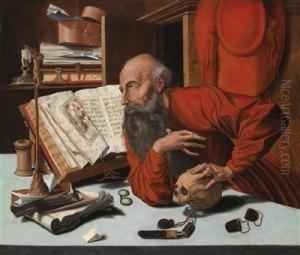Marinus Van Reymerswale Paintings
Marinus van Reymerswale was a Dutch Renaissance painter, active in the region of Zeeland from the early to mid-16th century. While there is limited biographical information available about Marinus, it is generally believed that he was born in the town of Reimerswaal, from which he adopted his name, around the year 1490. Not much is known about his early life or training, but it is assumed that he may have been a pupil of the Antwerp painter Quentin Matsys due to stylistic similarities, particularly in the rendering of figures and the use of satire to critique society.
Marinus is best known for his meticulous and satirical depictions of tax collectors, bankers, and lawyers, a subject matter that was quite unique and had a moralistic underpinning, reflecting the growing concern of his time with greed and corruption. His most famous works, such as 'The Tax Collectors', display a keen eye for detail and an almost caricature-like exaggeration of facial features, which served to enhance the moral message and to ridicule the subjects. These works are characterized by their vivid realism, precise detail, and use of strong, almost lurid, colors.
His paintings often included texts, proverbs, or biblical quotations that emphasized the moral lesson intended by the depiction of these avaricious characters. This combination of visual and textual elements made his work particularly engaging for the educated classes of his time.
Marinus' works were evidently popular in his lifetime, as indicated by the number of surviving copies and variations on his themes produced by other artists. Despite this, he seems not to have enjoyed a significant posthumous reputation, and his work fell into relative obscurity until the 20th century when art historians began to reassess his contribution to Northern Renaissance art.
The exact date of Marinus van Reymerswale's death is not known, but it is presumed he died around 1567. His works, while not extensive, are now recognized for their unique contribution to the Northern Renaissance, particularly for their social commentary and the ways in which they reflect the cultural and economic shifts of the 16th century.


